As an Amazon Associate I earn from qualifying purchases.
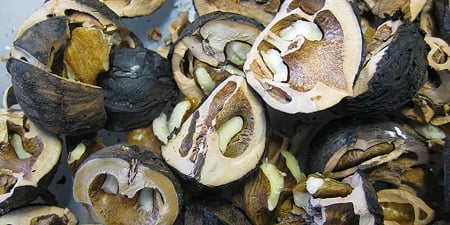
You’d think that if anything would bring out the Greed of Man in me, it would be truffles, a sexy, intoxicating food that can fetch $300 a pound or more. Yet I’ve given plenty of them away to my friends without a second thought.
No, what really makes me feel like Gollum from Lord of the Rings, the wild food I hold most precious, is my store of shelled black walnuts. Don’t even ask. You can’t have any. They are mine I tell you, all mine!
For those of you who don’t know what a black walnut is, it is a generic term for the wild walnuts native to North America. There is one main species east of the Rockies, two in California, and a couple of others in Arizona and Texas. Black walnuts are, more or less, related to hickory nuts and butternuts.
What’s the difference between black walnuts and the kind you get in the store? The vast majority of walnuts you buy in stores are English (also called Persian) walnuts, which are larger and easier to shell than black walnuts. In some places you can buy them in stores, and you can buy black walnuts online.
Size is not the main difference between black walnuts and domesticated ones. Flavor is. Black walnuts taste far stronger than regular ones: More concentrated, walnut-y, and even a touch more bitter.
To me they are the difference between cream and skim milk, grouse and chicken, a wild strawberry and one of those gigantic ones grown on the coast of California. I will take black walnuts over regular ones any time, and for any price.
Luckily that price is free: Black walnut trees grow all around us here in Northern California. My friend Josh tipped me off to a great spot, too, which has so many old trees it took my just 10 minutes to fill two 5-gallon buckets.
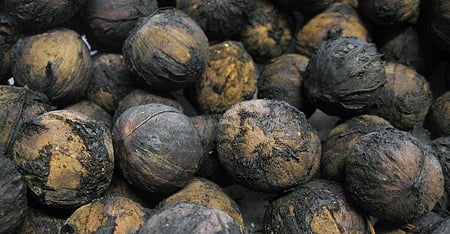
OK, maybe I lied. Black walnuts are not free — if you take time into consideration. Nothing I have ever done, not winemaking, gardening, big-game hunting, processing acorns or curing olives is as labor-intensive as harvesting, hulling and shelling black walnuts. As my fellow forager Connie Green says, “black walnuts are a fortress.” Here’s the method I figured out to storm the gates.
First you need to harvest the walnuts at the correct stage of ripeness.
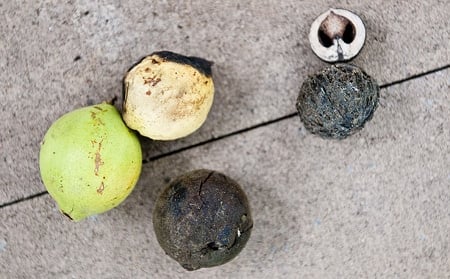
For starters, walnuts will probably not be ripe where you live until October, so wait until then to begin. November should be fine, too, and you can pick up fallen nuts from the ground around the trees into December, but by then our Little Gray Friends the squirrels will have had at them.
So you’re standing at a tree. You see all these forms of walnuts in front of you. Which to pick?
Green ones will most likely still be on the trees. Yes, you can collect them, but they have a surprise in store for you. The beige ones are rotting green ones — they are the hardest to work with, but the nut inside will still be fine. The black one at the bottom is how you will find most of your walnuts: It has its hull rotted and is pretty dry. Finally, if you’ve had lots of rain, you will find some nuts that will be pre-hulled, like the one under the half-shell.
Pick only pre-hulled walnuts that feel heavy for their size, as they will dry out in the shell once hulled.
For the most part, you will need to hull your walnuts. Lots of people say you should just drive over them with a car, but this stains your driveway. Stain? Why yes. Black walnut juice stains like nothing else. And it will not come off with any amount of scrubbing. If you fail to wear gloves when you hull black walnuts, you will have the Black Hand of Death for several days.
Sam Thayer, in his book Nature’s Garden, suggests stomping on the hulls in the field to get them off. This works, but incompletely in my experience with Northern California walnuts, Juglans hindsii. So I sit outside on my porch with three buckets — one with walnuts in it, one for the soon-to-be-hulled walnuts, and one for the hulls. I then don gloves and use a pocketknife to hull the nuts by hand.
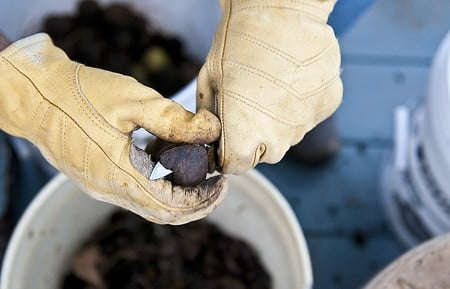
You want a relatively dull knife that you can slice with and not be in danger of it piercing your work gloves. The work can get a little slippery, especially with the green walnuts — remember the surprise? That’s it. A half-hulled green walnut is slipperier than goose shit on a doorknob. This is why I prefer the walnuts with the fully rotted black hulls.

Beware when you are hulling walnuts outdoors. Our Little Gray Friends could be lurking anywhere, just waiting to steal your walnuts for themselves. I use a biological countermeasure to keep the squirrels away:

Once hulled, your work has just begun. Now you must shell your walnuts.
This is the point at which you can kick back a bit. Hulled walnuts store well in the shell, and in fact crack better once they’ve dried for a few weeks.
Once you start shelling, however, you need to banish from your head all notions that you will be able to crack black walnuts and get those pretty perfect halves you can get with regular walnuts. Won’t happen. Bits and pieces are the price of precious black walnut meats.
I crack mine with a hammer, on the concrete floor of my garage. Such force is necessary. I’ve never heard of a regular nutcracker fierce enough to break a black walnut, although some people in the Midwest, where the Eastern species lives, have created special black walnut shellers. Anyone ever use one? I’ll buy one if they work well…
The key to the hammer technique is to use a terrycloth towel to cover the nuts, so the pieces don’t fly all over the room. Use a towel you don’t care about, as it will get holes. Smack the nut with enough force to break it, but not enough to pulverize the nut; after a few, you’ll get the hang of it.
So now you have a bucket of cracked nuts. You’re still not done! Now you need to gently remove the meats from the impossibly complex interior of the walnut. I find the best piece of equipment to do this is a stout pair of wire cutters and a nutpick. I use the wire cutters to clip the shells in key spots so larger pieces of walnut fall out. Again, after a few dozen nuts you’ll begin to know where to clip. The nutpick’s use is obvious. This is tedious work, people. I do it while watching football.
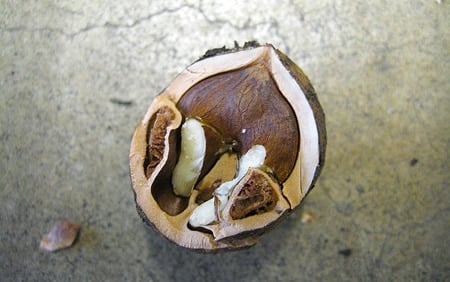
Let me tell you before you begin a black walnut adventure that you need to be patient. It took me probably six hours of work to get 15 ounces of nutmeats — although that includes hulling all of my nuts, not just the portion I cracked and picked. But all this work is worth it.
Just the aroma of black walnuts is payment for the effort: They smell toasted without actually being so. And I’ve already mentioned the flavor, which is so strong many recipes say just half the amount of black walnuts will fully replace the flavor of regular ones. I’m not so sure about that, but you can use a bit less. If you want.
Which brings me, finally, to what I do with my black walnuts. In holiday season, I make a Christmas cookie from my childhood:
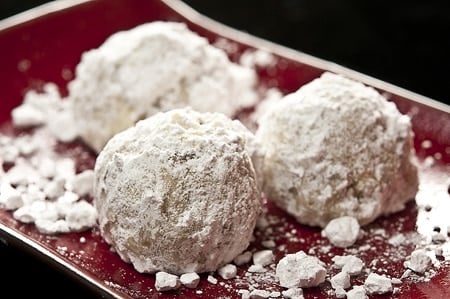
It is my version of a traditional walnut snowball cookie, also known as a Russian teacake or a Mexican wedding cake. My version has black walnuts, of course, but also orange flower water and a little orange liqueur. It’s an awesome cookie, a riff off one my mum has made for decades.
These cookies are stupid easy to make — no mixer necessary, just clean hands — and are so good you really need to make a double batch, because you will eat half of them before your friends or family come home. Trust me on this one.





Get a C E Potter nutcracker. They work great at cracking black walnuts. Do not think they are made anymore but they can be found at garage sales and auctions.
I harvested some last fall and also made a walnut stain for wood with the outer portions. The stain was a nice rich brown but haven’t used it except on some test wood. After curing for several months, I hated the taste of the nuts and put them outside a bucket at a time for the squirrels in the late winter. They were always gone within a couple hours with hoards of squirrels attacking the bucket. Now I see maybe if I toast them first in the oven, or use them in baking, they may taste better. If the rotten banana taste goes away, I may try it. Otherwise I will leave for the squirrels. One question is why do they leave them sitting in my yard all winter?
I grew up with lots of black walnuts, butternuts and hickory nuts in norther Illinois. Now live in Southern Ontario, where we haves lots of black walnuts. They are a tremendous amount of work, but well worth it. My grandmother harvested bushels of them. She sold the nutmeats by the quart jar. My favorite nut. Bake everything with them. They make an incredible liqueur. Don’t understand why they get such a bad review all over. People hate them. Think they are a nuisance. You just have to know how to deal with them. They are by all means a LOT of work. They are so worth the work. Watch the squirrels though. They will steal them all after you have removed the outer skin. The flavour is incredible. All three of these nuts. I find the best method is the vice. Hahaha…..There actually is a nutcracker for them though. Never tried it.
Hello Hank,
I live in Minnesota and have cracked walnuts for many years.
But not till last fall did I really get serious about it, I picked up two Ford ranger pickup boxes not quite level full from a couple yards.
I had my grand kids(3) help and we ran them through a hand corn sheller to take the hulls off, the greener the better, then put them on a slab to dry for two weeks then gathered them into five gallon buckets, about twenty five,
Then I built bins in the wall of one of my sheds, the bins are between the 6 X 6 posts and made of 1/4 in hardware cloth to keep mice, rats and other thieves out. I found a nut cracker from about 80 years ago and I built a separator box and a separator and now I can crack clean and sort a quart of ready to eat nuts in just under 90 minutes.
Working on an electric nut cracker with a 1.5 horse motor with a triple jaw and expect to be able to crack two five gallon pails in just over a minute, not sure how long it will take to sort and clean but should be much faster.
I’m going to have this cracker done by the end of February 2018 and hope it does not take to much fine tuning as I have about 18 five gallon pails to crack.
I’m looking at a power nut gatherer for next fall.
You can buy a Weasel rolling nut gatherer from Wizard online, makes picking off the ground much faster than by hand and you don’t have to bend over or crawl around on your knees.
Hello Hank, Thanks for sharing your story. Please continue.
My spouse and I live in Montreal, Canada. We collected many, many black walnuts in the area last fall… at least 10 5-gallon buckets worth. We removed the husks with thick gloves and a hammer, knowing full well the staining power of these wonderful nuts! After doing so, we cleaned the remaining bits of husk with water, drying the nuts on homemade dryers (chicken wire and 1×2 lumber) in our unheated garage. After a couple weeks, we removed them to store them in 2 small wood crate boxes and a huge mesh bag formerly used for kindling wood. Just recently, I cracked the nuts. As you said, the job still wasn’t done. Again with the hammer, we cracked the shells to enjoy this wonderful nut.
I tried them in a maple syrup and thick cream fudge. By far, I prefer them with a thin slice of baguette, brie and a dollop of apple & maple syrup. Mmm!!!
I bought a pair of 16″ channel lock pliers to crack them. But what temperature do you use to roast them in the oven, and how long?
Hi Hank – just found out about you and started reading your info. So excited to try some recipes. I love in Central Illinois and have plenty of acorns and make my own maple syrup. Can’t wait to try your cookie recipe. A couple of years ago I got a couple 5 gallon buckets of black walnuts and forgot they were in the back of the truck. I remembered them about a week later and after several rains. I drained the bucket and the husks just started falling off of them. I hosed off the rest in no time. So now, I just gather the nuts in a 5 gallon buckets, fill it with water for 3 or 4 days, hose them off and then dry them. I crack them with a bench vice in the garage while making my sirup. Enjoyed your articles and looking forward to more!
Hello!
Can I buy some from you? I also like them raw, not dry. Thank you
Helen: Nope, sorry.
Please where can I get the fresh Black walnut? I don’t like the dry ones. I live in MD
This is my first year of harvesting black walnuts. I agree with you on the idea that they are far superior to the domesticated variety of walnuts. I have harvested about 50 pounds hulled nuts and I am working with them in this form. Personally I like them raw but others close to me are not crazy about them in this form. Oh well, still experimenting!
I live in south central pa. , and have a number of trees close to my property. I have a barn and hull them on the barn floor by running over them with a small tractor. I then clean them in a small cement mixer with some water, two times.
When dried for a few weeks I crack them with a heavy duty vise that is mounted on A heavy duty table. THEY ARE A WOUNDERFUL TREAT. kEEP CRACKING AND PICKING
After years of hammering black walnuts on a concrete floor I purchased a cracker specifically constructed for them. It doesn’t take nearly as long as you suggest if you use the right tool (though it’s still fussy). Also, I stomp off as much of the green/brown jackets as I can “in the field.” When I get home I put the walnuts in a wash tub with some gravel and water, and rub the remaining material off, then let them dry for two to three weeks.
Thanks for your charming details on unlocking the black walnut. I discovered something this season that saved me some messy work. I put the hulled walnuts in very dry dirt to effectively pull off the last of the black slime. One week later I had dried walnuts and no flies pestering me or my walnuts. Now I can get cracking!
How long do you roast them and at what temperature?
Rhonda: About 10 minutes at 350F.
@RJT — Do tell! Please share whatever you remember about that!
Once you have hulled them, washed them, dried them for a couple of weeks, shelled them and have the pieces and parts of meat, is it best to oven roast them before using them in your favorite recipe or eating them by themselves. I noticed that raw, they taste a little too strong with the smell of the green hull and pulp. Almost a hint of iodine taste. Thoughts?
Steve: Yes, I roast them first.
What is with these walnuts? I crack them and they look delicious, but they taste somewhat “raw” Not like they normally taste. I do not know exactly how to describe the taste, just isn’t right. A day or two later and the piece I had left lying on the counter was dried up. Any help is appreciated.
Has anyone ever toasted black walnuts in the shell?
I think I saw this done and that the burned debris can be used to make paint. And that the whole process is messy.
Someone named Jane said you could put the raw meat and some inner shells in any kind of liquor to make black walnut extract. II suppose it would work.
I’m looking forward to harvesting black walnuts from trees my dad planted up here in Maine 40 years ago. Looks like it will be a good year for them on the trees we have. I already have harvested a few, but the weather has been unusually warm this fall.
Martha, i have scoured the internet trying to find out if all the nuts we cracked today are okay to cook with, we spent all day pickingblack walnuts up off thethe ground, hulking and then immediately cracking them with nut cracker my grandfather made just for black walnuts. Only to keep reading that we should have dried them for weeks first. Please help. Did we waste all that time?? Thanks cameron
Cameron: Well, it’s not ideal. These nuts won’t store well. They’re fine to eat, but use them soon and keep in the fridge.